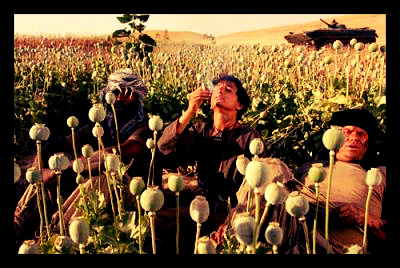Record Levels of Afghan Opium Production

Part of the U.S. war in Afghanistan has been centered on eradicating opium production and distribution in the war torn nation. Billions of dollars have been invested by the U.S. to achieve this end.
Unfortunately, the U.S. has objectively failed on all counts to realize this goal. Just this past year, Afghan opium was produced at record levels despite a hefty U.S. investment of $7 billion dollars.
Currently, the opium trade composes 15 percent of the Afghan economy. Its heroin production, derived from opium, accounts for over 75 percent of the entire world’s supply.
The prospects of significantly reducing poppy cultivation in Afghanistan seem slim at best due to its embedded nature within the culture as well as the extreme poverty most Afghans live in. The lucrative prices opium sells for can provide a decent living for Afghan families struggling to get by.
For example, just one kilogram of opium can sell for up to $200. This is significantly more money compared to the paltry 41 cents per kilogram one gets for selling wheat.
NPR profiled one farmer who makes $9,000 per year by producing 150 lbs of opium. No other opportunity in Afghanistan provides a comparable income.
Previous measures implemented by the Afghan government have been aimed at providing disincentives for farmers who desire to enter the drug trade. But, resources have become scarce in recent years, forcing the programs to be shuttered.
In one such program, the Afghan government subsidized alternative crops such as cotton. The subsidies inflated the price, making the move away from poppies more palatable for Afghan farmers.
The international community also attempted to provide disincentives by shipping seeds and fertilizer to farmers, but the program in no longer being implemented. Absent these programs, farmers simply return to the lucrative poppy trade.
One of the most disturbing consequences from the ubiquity of opium in the country is the presence of addicts in staggering numbers. Out of the total population of 35 million people, one million are currently addicted.
The treatment capacity to provide for these addicts is extremely limited. The government only has the ability to treat 20,000 people at any one time. Availability for treatment is limited depending on one’s location in the country.
Also, the ease at which one can obtain drugs in Afghanistan only adds to the problem. For instance, in Kabul, the price for heroin only amounts to $6 and to many is as easy to obtain as food.
The major security implications for the sale of these drugs lie with who directly benefits from the profits, namely the Taliban forces. The UK Daily Mail reports that in 2011 the Taliban is estimated to have earned up to $700 million dollars from the sale of opium and heroin.
The strategic importance of eliminating the opium trade in Afghanistan was typified by a comment made by former U.S. special envoy to Afghanistan, David Holbrooke. Holbrooke stated, “Breaking the narco-state in Afghanistan is essential, or all else will fail.”
With the inevitable troop draw down coupled with the uncertain status of a residual counterterrorism force to stay behind post-2014 — the possibility of making major headways toward eradicating the Afghan drug trade is nonexistent.
– Zachary Lindberg
Sources: NBC News, Daily Mail, NPR, Christian Science Monitor
Photo: GAIFF
